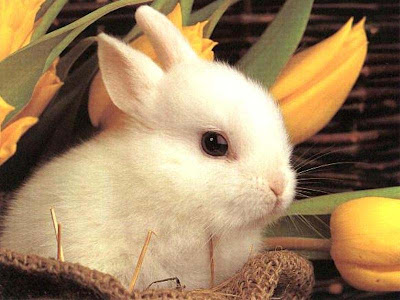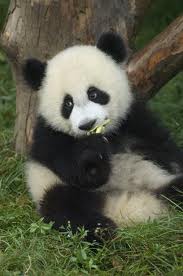Rare Bears
The giant panda is a medium-sized black-and-white bear that lives only in the mountainous temperate forests of southwest China. Giant pandas eat a diet of bamboo. The giant panda is one of the most endangered animals on Earth. Only about 1,600 of these rare bears are left. This number includes more than 160 pandas living in zoos and breeding centers around the world, mostly in China.
Creatures of the Forest
Giant pandas live in a few isolated mountain ranges in the provinces of Sichuan, Shaanxi, and Gansu in south-central China. They live in broadleaf and coniferous forests with a dense understory of bamboo, at elevations between 1500m and 3000m. Torrential rains, dense mists, and heavy cloud cover characterize these forests throughout much of the year. The giant panda has lived in bamboo forests for several million years. It is a highly specialized animal, with unique adaptations.
Bamboo for Every Meal
Bamboo is the giant panda's favorite food. Adult giant pandas will spend 10 to 16 hours a day finding and eating bamboo. They eat different parts of the plant depending on the time of year. In the summer and autumn, pandas munch mostly on leaves. Winter means a diet of tough stems. Spring provides tender, young bamboo shoots.
A giant panda’s digestive system is more similar to that of a carnivore than an herbivore. Because bamboo does not provide much nutrition, a panda needs to eat a large amount of food. It may eat up to 20kg of bamboo each day to get all the nutrients it needs.
Panda Parts
Giant pandas stand 1m tall at the shoulder (on all four legs) and are 1.5m long. Males are larger than females, weighing up to 115kg in the wild. Females rarely reach 100kg.
Giant pandas have a very specialized anatomy linking them to bamboo for survival. Their front paws are specially designed to allow them to hold bamboo stalks. Giant pandas appear to have thumbs. But these "thumbs" are really extensions of the wrist bone. To hold a piece of bamboo, a panda wraps its fingers around one side of the stalk. Then it holds it in place by pushing the wrist bone, or pseudo-thumb, forward.
Giving Birth in the Wild
Pink Pandas?Female giant pandas can become pregnant only once a year in the spring. Barking calls and scents draw males and females to each other. Females give birth between 95 and 160 days after mating. Females may give birth to two young pandas, but usually only one survives.
The bodies of newborn giant panda cubs are completely pink with a sparse covering of white hair. Giant pandas are not giants when they are born. Their eyes are closed, like a kitten, and they weigh only 120-175gr. They are around 15cm long - about the size of a hotdog!
After one week, dark patches begin to appear near the eyes and ears. Then the skin on their legs and backs begins to darken. Soon, black hair will grow in these areas and white hair everywhere else. Baby pandas’ eyes open when they are about one month old. They begin to crawl when they are three to four months old.
Mother Knows Best
Giant pandas are cubs until they are about two years old. Like all bears, they start to explore the world outside the den once they are strong enough to follow their mother’s lead. Giant panda mothers spend most of the time looking for bamboo shoots, stems, and tender leaves.
Young giant pandas use this time to learn about the forest and to climb trees. Cubs love to climb, and they quickly become very skilled. They have sharp, strong claws on both their front and back feet. Cubs may stay with their mothers for up to three years before striking out on their own.
Life Out in the Wild
An adult giant panda spends much of its day resting, seeking food, and eating. Unlike other bears from temperate climates, giant pandas do not hibernate Until recently, scientists thought giant pandas spent most of their lives alone. They believed that males and females met only during the breeding season.
Recent studies paint a different picture. Small groups of giant pandas share a large territory and sometimes meet outside the breeding season. Much remains to be learned about the secret lives of these animals. Every new discovery helps scientists in their battle to save this species.
Giving Birth in Captivity
Giant pandas are also born in captivity. Captive breeding centers were started because giant pandas are so endangered. The giant pandas’ naturally slow breeding rate prevents a population from recovering quickly from illegal hunting, habitat loss, and other human-related causes of death. The captive breeding centers provide a protected place for giant pandas to breed and for baby pandas to grow up. One of the most famous centers for breeding baby pandas is the Wolong Nature Reserve.
What to do with Twins
When pandas are born in captivity, they often have twins. Panda mothers will only care for one baby at a time. This means the keepers at the breeding center have to help care for the babies and keep them healthy. They feed the babies milk and keep them warm in incubators. The mother panda still gets to take care of both babies, but she cares for them one at a time.
Growing Up in Captivity
In captivity, young giant pandas remain together and have a chance to play. In the wild, it would be very rare for a young giant panda to meet another cub. This is because mother pandas live alone rather than in groups with other pandas. When panda cubs play, they appear to have lots of fun. But they are also learning important skills. For example, researchers hide snacks in hanging plastic tubes to teach the cubs how to search for food.
Branching Out From Bamboo
Giant pandas are now becoming easier to raise in captivity. This is because their keepers have discovered what foods to feed them. Cubs get a bowl of special milk for breakfast and lunch until they are about two years old. The milk is made by boiling rice and adding vitamins. Between the age of seven and nine months, panda cubs begin to snack on tender bamboo shoots. Other foods captive giant pandas eat include sugar cane, carrots, apples, and sweet potatoes. They also eat “panda bread” made from a mixture of ground bamboo, grains, and assorted vitamins and minerals.
Living Up to Their Name
Giant panda cubs grow quickly. Every few days, the staff at the breeding center must weigh them to check on their development. That includes lifting them onto a scale. This isn’t an easy job when the panda weighs almost as much as you do! No wonder they’re calledgiant pandas!
Pandas and People
In China, people and giant pandas have been living together for thousands of years. But China’s human population has been steadily growing. It is now the largest in the world. More people means more land is needed for farming. It also means more forests are cut for wood to build and heat houses. Loss of habitat in lowland areas has forced pandas to live only in the mountains.
Habitat Loss
The most damaging result of development has been that it has divided the panda’s habitat into little islands of forest. Today, many pandas are isolated in these small sections of forest, because they will cross into areas where humans live. The result is that the giant pandas cannot connect with one another to mate and have babies.
Make Room for Pandas
People are trying to help the giant panda survive by creating protected areas and breeding centers. China has 37 official areas for protecting the giant panda. All of these areas are in mountainous southwestern China. The Wolong Nature Reserve is one of the most famous.































